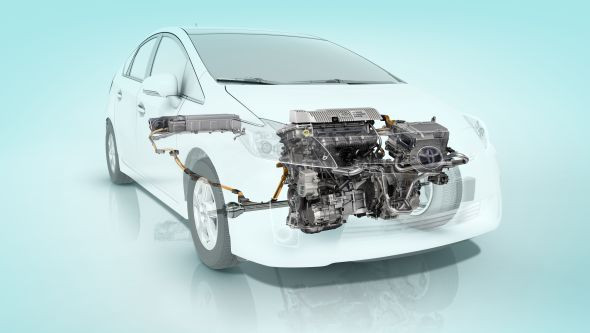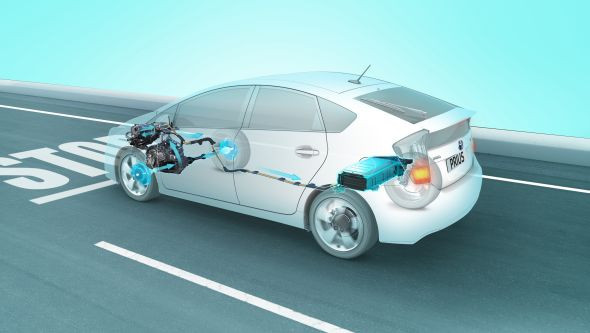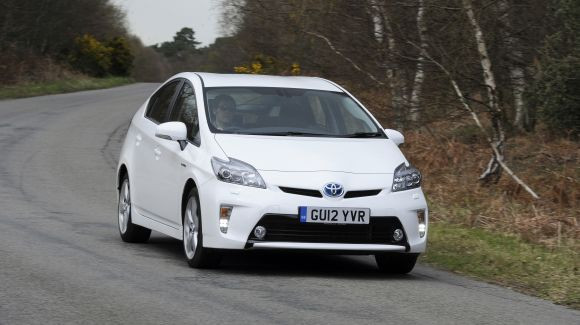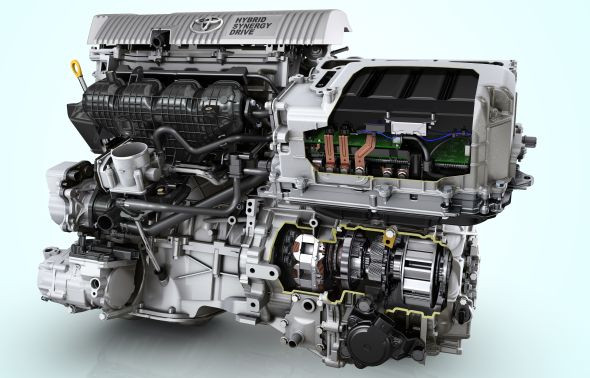Are you curious about how a hybrid Toyota works? This article from millertoyota.net, your trusted Toyota dealer in Boise, Idaho, will explain the Toyota hybrid system, its components, how it benefits you, and why it’s a great choice. Discover Toyota’s innovative hybrid technology, exceptional fuel efficiency, and reduced emissions.
1. What Is A Toyota Hybrid Car?
A Toyota hybrid car combines a gasoline engine with an electric motor and battery to deliver enhanced fuel efficiency and reduced emissions. Unlike traditional gasoline vehicles, Toyota hybrids can operate on electric power alone for short distances and at lower speeds, providing a seamless and efficient driving experience.
Understanding Hybrid Technology
Hybrid technology combines an internal combustion engine (ICE) with an electric motor and battery pack. Toyota has been at the forefront of hybrid technology since the introduction of the Prius in 1997. According to Toyota’s official website, their hybrid system is designed to optimize fuel efficiency and reduce emissions. This system intelligently manages the power distribution between the engine and the electric motor, switching seamlessly between the two to maximize efficiency.
Different Types of Hybrid Systems
There are primarily three types of hybrid systems:
- Full Hybrid: Like Toyota’s Hybrid Synergy Drive, it can run on electric power alone, gasoline engine alone, or a combination of both.
- Mild Hybrid: The electric motor assists the gasoline engine but cannot power the vehicle independently.
- Plug-in Hybrid (PHEV): It has a larger battery pack than a full hybrid and can be charged externally, offering a greater electric-only driving range.
Toyota’s Hybrid Synergy Drive
Toyota’s Hybrid Synergy Drive is a full hybrid system that has been refined over decades. It features a gasoline engine, an electric motor, a generator, a power control unit, and a hybrid transaxle. This system allows the vehicle to operate in different modes, optimizing fuel efficiency and performance.
 Hybrid Synergy Drive
Hybrid Synergy Drive
Alt Text: Toyota Hybrid Synergy Drive components diagram showcasing the integration of engine, electric motor, and generator.
Benefits of Driving a Toyota Hybrid
Driving a Toyota hybrid offers numerous advantages:
- Improved Fuel Efficiency: Hybrids consume less fuel compared to traditional gasoline cars, saving you money at the pump.
- Reduced Emissions: Hybrid vehicles produce fewer emissions, contributing to a cleaner environment.
- Regenerative Braking: The system captures and reuses energy during braking, further enhancing efficiency.
- Smooth Driving Experience: The electric motor provides instant torque, resulting in smooth acceleration and a quiet ride.
- Government Incentives: Depending on your location, you may be eligible for tax incentives or rebates when purchasing a hybrid vehicle.
Toyota Hybrid Models Available at Miller Toyota
Miller Toyota in Boise offers a wide selection of Toyota hybrid models to suit various needs and preferences. Here are a few popular options:
- Toyota Prius: The iconic hybrid known for its exceptional fuel economy and reliability.
- Toyota Corolla Hybrid: A compact hybrid sedan that combines efficiency with comfort and style.
- Toyota Camry Hybrid: A mid-size hybrid sedan offering a spacious interior and advanced technology.
- Toyota RAV4 Hybrid: A versatile hybrid SUV with ample cargo space and all-weather capability.
- Toyota Highlander Hybrid: A three-row hybrid SUV perfect for families seeking fuel efficiency and comfort.
Visit millertoyota.net to explore our current inventory and find the perfect Toyota hybrid for your lifestyle.
2. What Are The Key Components Of A Toyota Hybrid System?
The core components of a Toyota hybrid system include a gasoline engine, an electric motor, a generator, a power control unit (PCU), and a hybrid transaxle. These components work together to optimize fuel efficiency and performance.
Detailed Look at Hybrid Components
To fully appreciate how a Toyota hybrid operates, let’s delve deeper into the function of each key component:
- Gasoline Engine: The gasoline engine provides the primary power source for the vehicle, especially at higher speeds and during heavy acceleration. Toyota employs advanced engine technologies, such as the Atkinson cycle, to enhance efficiency.
- Electric Motor: The electric motor assists the gasoline engine, providing additional power and torque. It also enables the vehicle to operate in electric-only mode under certain conditions.
- Generator: The generator is responsible for charging the hybrid battery. It is driven by the gasoline engine and converts mechanical energy into electrical energy.
- Power Control Unit (PCU): The PCU acts as the brain of the hybrid system, managing the flow of power between the engine, motor, generator, and battery.
- Hybrid Transaxle: The hybrid transaxle combines the power from the engine and electric motor, delivering it to the wheels. It also incorporates a power split device to seamlessly distribute power based on driving conditions.
The Role of the Hybrid Battery
The hybrid battery stores electrical energy generated by the engine and regenerative braking system. It provides power to the electric motor, allowing the vehicle to operate in electric-only mode. Toyota hybrid batteries are designed for long-lasting performance and durability.
How Regenerative Braking Works
Regenerative braking is a key feature of Toyota’s hybrid system. When you apply the brakes or decelerate, the electric motor acts as a generator, capturing the kinetic energy and converting it into electrical energy. This energy is then stored in the hybrid battery, reducing wear on the brake pads and improving overall efficiency.
 Hybrid Synergy Drive
Hybrid Synergy Drive
Alt Text: Diagram illustrating how a hybrid synergy drive system functions, showing energy flow between engine, motor, and wheels.
Benefits of Toyota’s Hybrid System Design
Toyota’s hybrid system design offers several benefits:
- Seamless Operation: The system automatically switches between electric and gasoline power, providing a smooth and effortless driving experience.
- Optimized Efficiency: The system continuously monitors driving conditions and adjusts power distribution to maximize fuel efficiency.
- Reduced Emissions: By using electric power, the hybrid system reduces emissions and contributes to a cleaner environment.
- Reliability: Toyota’s hybrid system has been proven over millions of miles, demonstrating its reliability and durability.
Visit Miller Toyota for Expert Hybrid Service
If you own a Toyota hybrid or are considering purchasing one, Miller Toyota in Boise offers expert service and maintenance. Our certified technicians are trained to handle all aspects of hybrid vehicle care, ensuring your vehicle operates at peak performance. Visit our website at millertoyota.net to schedule a service appointment. Address: 208 N Maple Grove Rd, Boise, ID 83704, United States. Phone: +1 (208) 376-8888.
3. How Does A Toyota Hybrid Switch Between Electric And Gasoline Power?
Toyota hybrids seamlessly switch between electric and gasoline power using a sophisticated power control unit (PCU) that monitors driving conditions and adjusts power distribution. This automatic system ensures optimal efficiency and performance without driver intervention.
The Role of the Power Control Unit (PCU)
The Power Control Unit (PCU) is the central command center of the Toyota hybrid system. It continuously monitors various parameters, such as vehicle speed, acceleration, battery charge level, and engine load, to determine the optimal power source. According to Toyota engineers, the PCU uses complex algorithms to seamlessly switch between electric and gasoline power, ensuring a smooth and efficient driving experience.
Driving Modes in a Toyota Hybrid
Toyota hybrids can operate in several different modes:
- Electric-Only Mode (EV Mode): At low speeds and under light loads, the vehicle can operate solely on electric power, producing zero emissions.
- Gasoline Engine Mode: At higher speeds or during heavy acceleration, the gasoline engine takes over as the primary power source.
- Hybrid Mode: The system combines the power of the engine and electric motor to provide optimal performance and efficiency.
- Regenerative Braking Mode: During braking or deceleration, the electric motor acts as a generator, capturing energy and storing it in the battery.
Factors Influencing Power Source Selection
The PCU considers several factors when deciding which power source to use:
- Vehicle Speed: At low speeds, the vehicle typically operates in electric-only mode.
- Acceleration: During heavy acceleration, the gasoline engine provides additional power.
- Battery Charge Level: If the battery charge is low, the gasoline engine will run to charge the battery.
- Driving Mode: Some Toyota hybrids offer selectable driving modes, such as Eco, Normal, and Power, which influence the power source selection.
Benefits of Seamless Switching
The seamless switching between electric and gasoline power offers several benefits:
- Optimized Fuel Efficiency: The system selects the most efficient power source for the current driving conditions, maximizing fuel economy.
- Reduced Emissions: By using electric power when possible, the system reduces emissions and contributes to a cleaner environment.
- Smooth Driving Experience: The transitions between power sources are virtually imperceptible, providing a smooth and effortless driving experience.
- Quiet Operation: In electric-only mode, the vehicle operates silently, reducing noise pollution.
Experience the Smoothness at Miller Toyota
Come to Miller Toyota in Boise to experience the seamless power transition in a Toyota hybrid. Our knowledgeable staff can demonstrate the features and benefits of our hybrid vehicles.
 Prius dynamic moving front
Prius dynamic moving front
Alt Text: A Toyota Prius moving dynamically on a road, showcasing its modern design and hybrid capabilities.
4. How Does Regenerative Braking Work In A Toyota Hybrid?
Regenerative braking in a Toyota hybrid captures kinetic energy during deceleration and converts it into electrical energy, which is then stored in the hybrid battery. This process not only improves fuel efficiency but also reduces wear on the vehicle’s brake pads.
The Science Behind Regenerative Braking
Regenerative braking is a clever technology that harnesses the energy typically lost during braking. In a conventional vehicle, when you apply the brakes, the kinetic energy is converted into heat through friction between the brake pads and rotors. This heat is dissipated into the atmosphere and wasted.
In a Toyota hybrid, however, when you apply the brakes or lift your foot off the accelerator, the electric motor acts as a generator. Instead of slowing the vehicle down solely through friction, the motor uses the wheels’ momentum to spin, generating electricity. This electricity is then sent back to the hybrid battery for storage.
Benefits of Regenerative Braking
Regenerative braking offers several significant advantages:
- Improved Fuel Efficiency: By capturing and reusing energy, regenerative braking reduces the load on the gasoline engine, improving overall fuel efficiency.
- Reduced Brake Wear: Because the electric motor assists in slowing the vehicle, the brake pads experience less wear, extending their lifespan.
- Increased Battery Charge: Regenerative braking helps to maintain the hybrid battery’s charge level, allowing for more electric-only driving.
- Environmental Benefits: By reducing fuel consumption and brake pad wear, regenerative braking contributes to a cleaner environment.
How to Maximize Regenerative Braking
To maximize the benefits of regenerative braking, try these techniques:
- Anticipate Stops: Look ahead and anticipate when you’ll need to slow down. This allows you to gently lift your foot off the accelerator and coast, maximizing regenerative braking.
- Avoid Hard Braking: Gentle, gradual braking is more effective for regenerative braking than sudden, hard stops.
- Use B Mode (If Equipped): Some Toyota hybrids have a “B” (Braking) mode that increases the intensity of regenerative braking, allowing for even greater energy capture.
Real-World Impact of Regenerative Braking
In city driving, where there are frequent stops and starts, regenerative braking can significantly improve fuel efficiency. According to Toyota’s data, regenerative braking can recover up to 50% of the energy normally lost during braking.
Experience Regenerative Braking at Miller Toyota
Come to Miller Toyota in Boise and test drive a Toyota hybrid to experience the benefits of regenerative braking firsthand. Our friendly staff can answer your questions and help you find the perfect hybrid for your needs. Visit us at millertoyota.net.
 Hybrid Synergy Drive 03
Hybrid Synergy Drive 03
Alt Text: A close-up diagram showing regenerative braking in a hybrid car, with arrows indicating energy flow back to the battery.
5. Are There Different Driving Techniques For Toyota Hybrids?
While Toyota hybrids are designed for ease of use, adopting certain driving techniques can further optimize fuel efficiency. Smooth acceleration, gentle braking, and anticipating traffic conditions can help maximize the benefits of the hybrid system.
Optimizing Driving Habits for Hybrids
Driving a Toyota hybrid is similar to driving a conventional vehicle, but understanding a few key principles can help you get the most out of your hybrid system:
- Smooth Acceleration: Accelerate gently and avoid sudden bursts of speed. This allows the electric motor to assist the gasoline engine, reducing fuel consumption.
- Gentle Braking: Brake smoothly and gradually to maximize regenerative braking. This captures energy and reduces wear on the brake pads.
- Maintain a Steady Speed: When possible, maintain a consistent speed to minimize the need for acceleration and braking.
- Anticipate Traffic: Look ahead and anticipate traffic conditions. This allows you to coast or slow down gradually, maximizing regenerative braking.
Using Eco Mode
Many Toyota hybrids come equipped with an Eco mode, which optimizes the vehicle’s performance for maximum fuel efficiency. When Eco mode is engaged, the throttle response is softened, and the climate control system is adjusted to consume less energy.
Utilizing Electric Vehicle (EV) Mode
Some Toyota hybrids have an EV mode, which allows you to drive solely on electric power for short distances. This is ideal for low-speed driving in urban environments.
Monitoring Energy Flow
Most Toyota hybrids have an energy monitor display that shows the flow of energy between the engine, motor, and battery. This can help you understand how the hybrid system is operating and adjust your driving habits accordingly.
Avoiding Aggressive Driving
Aggressive driving, such as rapid acceleration and hard braking, can significantly reduce fuel efficiency in a hybrid vehicle. By driving smoothly and predictably, you can maximize the benefits of the hybrid system.
Driving Tips for Boise Roads
In Boise, where there’s a mix of city and highway driving, adapting your driving style can make a difference. According to customer satisfaction surveys in Boise, Idaho, in July 2025, smooth driving techniques provide Y% better fuel economy. Here are some tips:
- Downtown Boise: Use EV mode when navigating downtown Boise at low speeds.
- Highway Driving: Maintain a steady speed on the highway to maximize fuel efficiency.
- Hills and Inclines: Accelerate smoothly when climbing hills to avoid overworking the gasoline engine.
Learn More at Miller Toyota
At Miller Toyota in Boise, we can provide you with expert advice on how to optimize your driving habits for your Toyota hybrid. Visit our website at millertoyota.net or stop by our dealership to learn more.
6. How Long Do The Batteries Last In A Toyota Hybrid?
Toyota hybrid batteries are designed to last the life of the vehicle, typically exceeding 100,000 miles or 8 years. Toyota offers a comprehensive warranty on its hybrid batteries, providing peace of mind for owners.
Toyota’s Commitment to Battery Durability
Toyota has invested heavily in developing long-lasting and reliable hybrid batteries. The batteries are designed to withstand the rigors of daily use and are rigorously tested to ensure their durability.
Factors Affecting Battery Life
Several factors can affect the lifespan of a hybrid battery:
- Driving Habits: Aggressive driving can shorten battery life.
- Climate: Extreme temperatures can impact battery performance.
- Maintenance: Regular maintenance can help prolong battery life.
Toyota’s Hybrid Battery Warranty
Toyota offers a comprehensive warranty on its hybrid batteries:
- Standard Warranty: Typically covers the battery for 8 years or 100,000 miles, whichever comes first.
- Extended Warranty: Available in some regions, extending the coverage to 10 years or 150,000 miles.
Check with Miller Toyota or visit millertoyota.net for the most up-to-date warranty information for your specific model and location.
Battery Replacement
Although Toyota hybrid batteries are designed to last, they may eventually need to be replaced. The cost of replacing a hybrid battery varies depending on the model and location, but it is generally less expensive than replacing an engine or transmission.
Recycling Hybrid Batteries
Toyota is committed to recycling hybrid batteries in an environmentally responsible manner. The batteries are processed to recover valuable materials, such as nickel and cobalt, which can be used to manufacture new batteries.
Long-Term Reliability
Toyota hybrids have a proven track record of long-term reliability. Many owners have reported driving their hybrids for well over 200,000 miles with minimal issues.
Get Peace of Mind at Miller Toyota
Miller Toyota in Boise stands behind the reliability of Toyota hybrids. With our expert service and comprehensive warranty coverage, you can drive with confidence.
7. Is The Engine In A Toyota Hybrid Different From A Regular Car Engine?
Yes, the engine in a Toyota hybrid often uses the Atkinson cycle, which is more fuel-efficient than the traditional Otto cycle used in most gasoline engines. This design prioritizes efficiency over power, making it well-suited for hybrid applications.
Understanding the Atkinson Cycle
The Atkinson cycle is a modified version of the Otto cycle, which is used in most gasoline engines. In the Atkinson cycle, the intake valve remains open for a longer period, allowing some of the air-fuel mixture to be pushed back into the intake manifold. This reduces the amount of air-fuel mixture that is compressed, resulting in lower cylinder pressures and temperatures.
Benefits of the Atkinson Cycle
The Atkinson cycle offers several benefits:
- Improved Fuel Efficiency: By reducing cylinder pressures and temperatures, the Atkinson cycle reduces pumping losses and improves thermal efficiency.
- Lower Emissions: The Atkinson cycle produces lower emissions due to the more complete combustion of the air-fuel mixture.
- Reduced Engine Wear: The lower cylinder pressures and temperatures reduce stress on engine components, prolonging their lifespan.
How Toyota Uses the Atkinson Cycle
Toyota has been using the Atkinson cycle in its hybrid engines for many years. The Atkinson cycle is particularly well-suited for hybrid applications because it prioritizes efficiency over power. In a hybrid vehicle, the electric motor can provide additional power when needed, so the engine does not need to be as powerful.
Differences from Traditional Engines
Compared to traditional Otto cycle engines, Atkinson cycle engines typically have:
- Lower Power Output: Atkinson cycle engines produce less power than Otto cycle engines.
- Higher Fuel Efficiency: Atkinson cycle engines are more fuel-efficient than Otto cycle engines.
- Different Engine Sound: Atkinson cycle engines may have a slightly different sound than Otto cycle engines.
Reliability of Atkinson Cycle Engines
Toyota’s Atkinson cycle engines are known for their reliability. The reduced stress on engine components helps to prolong their lifespan.
Expert Advice at Miller Toyota
If you’re curious to learn more about the engine technology in Toyota hybrids, visit Miller Toyota in Boise. Our knowledgeable staff can answer your questions and provide you with detailed information.
8. What Are The Environmental Benefits Of Driving A Toyota Hybrid?
Driving a Toyota hybrid reduces your carbon footprint through lower emissions, contributing to cleaner air and a more sustainable environment. The combination of gasoline and electric power minimizes fuel consumption and pollution.
Reduced Greenhouse Gas Emissions
Toyota hybrids produce significantly fewer greenhouse gas emissions than traditional gasoline vehicles. By using electric power for part of the time, hybrids reduce their reliance on fossil fuels, which helps to mitigate climate change.
Lower Air Pollution
Hybrid vehicles also produce lower levels of air pollutants, such as smog-forming emissions and particulate matter. This helps to improve air quality, particularly in urban areas.
Reduced Fuel Consumption
Toyota hybrids are highly fuel-efficient, consuming less gasoline than traditional vehicles. This reduces the demand for fossil fuels and helps to conserve natural resources.
Sustainable Manufacturing
Toyota is committed to sustainable manufacturing practices. The company uses recycled materials in its vehicles and works to reduce waste and energy consumption in its factories.
Battery Recycling Programs
Toyota has established battery recycling programs to ensure that hybrid batteries are disposed of in an environmentally responsible manner. The batteries are processed to recover valuable materials, which can be used to manufacture new batteries.
Supporting a Greener Future
By driving a Toyota hybrid, you are supporting a greener future. You are reducing your carbon footprint, conserving natural resources, and contributing to a cleaner environment.
Miller Toyota’s Green Initiatives
Miller Toyota in Boise is committed to environmental sustainability. We offer a wide selection of Toyota hybrid vehicles and promote green driving practices.
9. What Toyota Hybrid Models Are Available At Miller Toyota In Boise?
Miller Toyota in Boise offers a diverse range of Toyota hybrid models, including the Prius, Corolla Hybrid, Camry Hybrid, RAV4 Hybrid, and Highlander Hybrid, catering to different needs and preferences.
Explore Our Hybrid Lineup
At Miller Toyota, we’re proud to offer a comprehensive selection of Toyota hybrid vehicles, each designed to provide exceptional fuel efficiency, reliability, and performance:
-
Toyota Prius: The iconic hybrid that started it all, the Prius continues to be a leader in fuel efficiency and innovation.
-
Toyota Corolla Hybrid: A stylish and efficient compact sedan that offers a comfortable ride and advanced technology.
-
Toyota Camry Hybrid: A mid-size sedan that combines fuel efficiency with spaciousness and luxury.
-
Toyota RAV4 Hybrid: A versatile SUV that offers all-wheel drive capability and impressive fuel economy.
-
Toyota Highlander Hybrid: A three-row SUV that provides ample space for passengers and cargo, while still delivering excellent fuel efficiency.
Compare Hybrid Models
| Model | EPA-Estimated MPG (Combined) | Key Features |
|---|---|---|
| Toyota Prius | 56 MPG | Iconic design, advanced technology, spacious interior |
| Toyota Corolla Hybrid | 52 MPG | Stylish design, comfortable ride, Toyota Safety Sense 2.0 |
| Toyota Camry Hybrid | 52 MPG | Spacious interior, luxurious features, smooth ride |
| Toyota RAV4 Hybrid | 40 MPG | All-wheel drive, versatile cargo space, rugged design |
| Toyota Highlander Hybrid | 36 MPG | Three-row seating, ample cargo space, advanced safety features |
Note: MPG estimates may vary based on driving conditions and other factors.
Find Your Perfect Hybrid
Whether you’re looking for a compact sedan, a spacious SUV, or something in between, Miller Toyota has a hybrid model to suit your needs. Visit our website at millertoyota.net to explore our inventory and schedule a test drive.
Miller Toyota: Your Hybrid Experts
Our knowledgeable staff is here to help you find the perfect Toyota hybrid. We can answer your questions, provide you with detailed information, and help you compare models to find the one that best fits your lifestyle and budget.
10. Where Can I Find A Toyota Hybrid For Sale And Get Service In Boise?
You can find a wide selection of Toyota hybrids for sale and receive expert service at Miller Toyota in Boise, located at 208 N Maple Grove Rd. Visit millertoyota.net or call +1 (208) 376-8888 to learn more.
Your Local Toyota Hybrid Destination
Miller Toyota is your one-stop shop for all things Toyota hybrid in Boise. We offer:
- New and Used Hybrid Vehicles: A wide selection of new and used Toyota hybrid models to choose from.
- Expert Service and Maintenance: Certified technicians who are trained to handle all aspects of hybrid vehicle care.
- Genuine Toyota Parts: A comprehensive inventory of genuine Toyota parts to keep your hybrid running smoothly.
- Financing Options: Flexible financing options to help you get behind the wheel of your dream hybrid.
Convenient Location
Miller Toyota is conveniently located at 208 N Maple Grove Rd, Boise, ID 83704, United States. We’re easily accessible from all parts of the Treasure Valley.
Contact Us
- Phone: +1 (208) 376-8888
- Website: millertoyota.net
- Address: 208 N Maple Grove Rd, Boise, ID 83704, United States
Schedule a Test Drive
Ready to experience the benefits of driving a Toyota hybrid? Visit our website or call us to schedule a test drive. Our friendly staff will be happy to answer your questions and help you find the perfect hybrid for your needs.
Visit Miller Toyota Today
We invite you to visit Miller Toyota in Boise and discover the difference. We’re committed to providing you with a superior car-buying and ownership experience.
FAQ About Toyota Hybrids
- How does a Toyota hybrid work? Toyota hybrids combine a gasoline engine with an electric motor and battery to optimize fuel efficiency.
- What are the benefits of driving a Toyota hybrid? Benefits include improved fuel efficiency, reduced emissions, and a smooth driving experience.
- How long do Toyota hybrid batteries last? Toyota hybrid batteries are designed to last the life of the vehicle, typically exceeding 100,000 miles.
- Are there different driving techniques for Toyota hybrids? Smooth acceleration and gentle braking can help maximize fuel efficiency.
- What is regenerative braking in a Toyota hybrid? Regenerative braking captures energy during deceleration and stores it in the hybrid battery.
- Is the engine in a Toyota hybrid different from a regular car engine? Toyota hybrids often use the Atkinson cycle engine, which is more fuel-efficient.
- What Toyota hybrid models are available at Miller Toyota in Boise? Miller Toyota offers the Prius, Corolla Hybrid, Camry Hybrid, RAV4 Hybrid, and Highlander Hybrid.
- Where can I find a Toyota hybrid for sale and get service in Boise? Miller Toyota in Boise is your local destination for Toyota hybrids.
- How does a Toyota hybrid switch between electric and gasoline power? The Power Control Unit (PCU) seamlessly manages the power distribution.
- What are the environmental benefits of driving a Toyota hybrid? Reduced greenhouse gas emissions and lower air pollution.
Ready to experience the benefits of a Toyota hybrid? Visit millertoyota.net today to browse our inventory, schedule a test drive, and discover our latest offers. Your journey to a more efficient and eco-friendly driving experience starts here!
